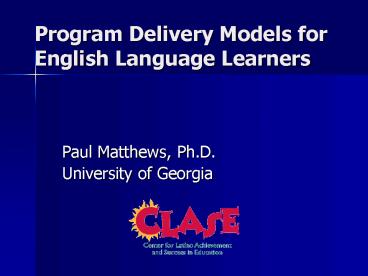Program Delivery Models for English Language Learners - PowerPoint PPT Presentation
1 / 16
Title:
Program Delivery Models for English Language Learners
Description:
Program Delivery Models for English Language Learners Paul Matthews, Ph.D. University of Georgia Program Models What & Why? All students legally and morally ... – PowerPoint PPT presentation
Number of Views:146
Avg rating:3.0/5.0
Title: Program Delivery Models for English Language Learners
1
Program Delivery Models for English Language
Learners
- Paul Matthews, Ph.D.
- University of Georgia
2
Program Models What Why?
- All students legally and morally deserve an
appropriate education. - Must provide adequate instruction for ELLs (Lau
v. Nichols, 1974). Violation of Title VI if
programs dont teach English as soon as
possible/not a dead-end track parents must
receive information in language they can
understand. - 14th Amendment prohibits states from denying
public education to undocumented children (Plyler
v. Doe, 1982)
3
Program Models What Why?
- Compliance with Equal Ed. Opp. Act criteria (1)
program informed by an educational theory
recognized as sound by some experts in the field
or, at least, deemed legitimate experimental
strategy (2) program and practice reasonably
calculated to implement effectively the
educational strategy adopted (3) program
succeeds in producing results indicating that
the language barriers are actually being
overcome (Castaneda v. Pickard, 1981) - Appropriate instruction with endorsed teacher,
meeting class size limits, placement into/out of
correctly, can receive federal via state DOE.
4
Class Size Limits (GA)
- Grade Levels Maximum Individual Class Size
- K-3 No aide 9, with aide 11
- 4-8 No aide 11, with aide 14
- 9-12 No aide 13, with aide 18A segment
one-sixth of the instructional day. This minimum
time varies by grade level as do minimum segment
lengths Grades K-3 270 minutes a week per
day 45 minute segmentsGrades 4-5 300 minutes
a week per day 50 minute segments Grades 6-12
330 minutes a week per day 55 minute
segments. In addition, a segment consists of at
least the minimum number of minutes required to
earn a Carnegie unit in Grades 9-12.
5
Submersion
- No support given Sink or Swim
- Teachers may assume ELLs are someone elses
problem - Inappropriate or no modification of instruction,
assessment, activities - Likely a violation of students civil rights
6
Newcomers Programs
- Sometimes a separate facility
- Usually offer intensive, short-term survival
ESOL (e.g., 2 of 4 blocks are English) - May be coupled with sheltered courses
- May not have access to mainstream
activities/social groups
7
Pull-Out ESOL
- Teachers (should be) ESOL endorsed
- Class size limited
- Most common instructional methodology
- Not always integrated with regular curriculum
- May marginalize students when pulled out of fun
or helpful activities ESOL teachers, classrooms
often under-funded
8
Sheltered Instruction
- Can be for full-day (elementary) or separate
classes - Teachers ideally trained in ESOL and content area
- Instruction is modified for ELLs
- Can get grade-level academic credit
- May create segregated setting with little peer
language interaction - www.siopinstitute.net/
9
Inclusion/Push-In
- ESOL teacher co-teaches in regular classroom
- Usually elementary-school past this can do a
pre-teaching model - Can minimize segregation and disruption of
routines - Requires joint planning time
- Personalities must work together and must treat
as equals - May need more teachers
10
Bilingual Programs
- Legal in Georgia (state law)
- Not everyone uses bilingual in same sense. Need
to differentiate based on - Goals transitional or maintenance/developmental
- Early-exit or late-exit
- Models by day, by class, by topic, by
instructor, 50/50 or 90/10 - 1-way or 2-way immersion
- Difficult to implement in Georgia
(infrastructure) - Which languages?
- Which language variety?
- What teachers?
- Not always well done can segregate students
11
Thomas Colliers research
- http//www.crede.ucsc.edu/research/llaa/1.1es.html
- Research from 1985-2001
- Multi-site, multi-language, looked at wide range
of programs including ESOL, bilingual, and others - Results support importance of L1 in education
12
Thomas Collier
- only ELLs with at least 4 years of primary
language schooling reach grade-level performance
in L2 in 4 years. As a group, students with no
primary language schooling are not able to reach
grade-level performance in L2. - The highest quality ESL Content programs close
about half of the total achievement gap.
13
Effective Programs (Romo)
- High expectations for all students
- Sufficient time in program to develop bilingual
skills - Rigorous academic content in the curriculum
- Quality language instruction
- School climate that values bilingualism
- Positive opportunities to interact socially with
speakers of L2
14
Things to watch out for
- Pressure to lose/abandon L1
- Pressure to take low-track classes tracking into
courses which are not college-bound negative
peer influence from low-achieving students - Low expectations
- Marginalization/lack of access to English-using
peers - Teachers who dont understand SLA or who dont
take responsibility for students
15
What will your school do?
- Think about needs in present AND future
- What programs will best serve ELLs?
- What resources and training needed?
- Who helps make the decisions about program
models? Do they have the necessary information? - Who makes decisions about student placements? Do
they have the necessary information?
16
- Paul Matthews, pmatthew_at_uga.edu
- Center for Latino Achievement and Success in
Education (CLASE), www.coe.uga.edu/clase - 706-542-3368































